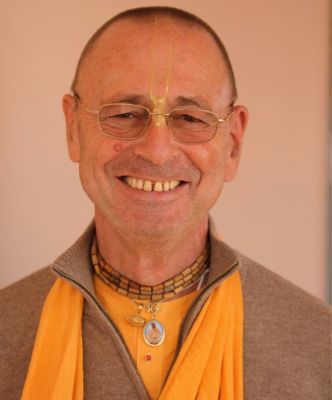Sivarama Swami Features New Vrindaban In His Book Intro
Below is an excerpt from the introduction to “Nava Vraja Mahima,” the nine volume series is “an epic work of over 4,000 pages on The Glories of New Vraja Dhama,” written by His Holiness Sivarama Swami.
——————————–
Among Srila Prabhupada’s many innovations is the concept of “farming communities,” of which the first was New Vrindaban. The instructions that Srila Prabhupada gave the leaders of New Vrindaban were extrapolated from two of the seven “purposes” included in ISKCON’s original articles of incorporation: “To erect for the members and for society at large a holy place of transcendental pastimes dedicated to the Personality of Krsna” and “To bring the members closer together for the purpose of teaching a simpler and more natural way of life.”
Srila Prabhupada envisioned that these purposes could be realized in New Vrindaban if the devotees there concentrated their efforts on cow protection, sustainable agriculture, simple village life, and higher learning. It was also essential, he instructed, that they make New Vrindaban into a place of pilgrimage and an environment in which anyone could learn to love Krsna. Though perhaps never presented as such, these principles can be seen as New Vrindaban’s founding principles.
Srila Prabhupada saw that the expansive area of New Vrindaban provided an opportunity not only for his followers to live as Krsna did, but also to remap Krsna’s land on the natural topography of the Appalachian Hills. As was the case in Visnupura, Srila Prabhupada had the natural features of New Vrindaban identified with those of Vraja – the hills would become Govardhana, the lakes Radha-kunda and Syama-kunda – indeed, Prabhupada wanted New Vrindaban to be a “replica of Old Vrindavana.” In his transcendental ambition to glorify Krsna, Srila Prabhupada also envisioned that seven hills of New Vrindaban should each feature a separate temple with its own Radha-Krsna Deities to commemorate the seven main Deities of Bhauma Vrindavana. In short, Srila Prabhupada envisaged that his American followers “should have a place like Vrindavana.”
While encouraging the development of New Vrindaban, Srila Prabhupada was also constructing a temple in Bhauma Vrindavana. ISKCON’s history testifies to the great pains Srila Prabhupada endured to establish the Krsna-Balarama temple in Vrindavana. It would be a place where his disciples could visit the original land of Krsna and where their children could study in Gurukula and naturally become Krsna conscious.
And while pouring energy and resources into ISKCON Vrindavana, Srila Prabhupada knew that it would not be possible for all of his followers to visit, what to speak of reside there. Thus he continued to encourage the global development of farming communities based on the template of New Vrindaban – holy dhamas in the Western world. Devotees could be successful in their efforts to establish these Western dhamas provided that they followed Prabhupada’s instructions. The potency to invoke the dhama was with Srila Prabhupada, and those who sincerely followed His Divine Grace could be empowered instruments in his will.
While other farming communities were established during Srila Prabhupada’s time, His Divine Grace did not directly instruct that they “replicate” Vraja, as he had done in the case of New Vrindaban. Instead he emphasized self-sufficiency and communal living based on the principles of varnasrama-dharma. In all cases, however, he installed Deities at the center of the community, and by his disciples’ adhering to the activities of pure devotional service, those farming communities also became holy places.
CLICK HERE for more info about Sivarama Swami’s books.




